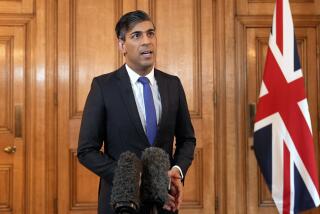Afghan war troop deaths surged in July
- Share via
KABUL, AFGHANISTAN — The month began with a fatal roadside bombing and ended with word that an American had died of wounds suffered in a firefight. After nearly eight years of warfare in Afghanistan, July proved by far the deadliest month yet for U.S. troops and their foreign allies.
Bombs and rocket attacks, ambushes and aviation accidents killed many of the 72 foreign troops, including 43 Americans, according to data at the website icasualties.org. Previously, the highest monthly U.S. toll was 28 in June 2008, according to the independent website.
July was also the worst month for Britain, the most important U.S. ally in Afghanistan, since the 1980s Falklands war. Twenty-two British soldiers died, spurring soul-searching in a country where a recent poll suggested that a majority of the public considers the Afghan war unwinnable.
Analysts and military officials cited a web of factors in the record death toll, including a major American military offensive in the south and a parallel push by British troops.
Also driving the increased casualty count is the growing U.S. troop presence, Western forays into previously Taliban-dominated areas and a determined, resilient insurgency.
“It’s a strong example of the asymmetric nature of Taliban and insurgent tactics and procedures,” said Seth Jones, an Afghanistan expert with Rand Corp.
“There’s been a decision to scatter and target NATO forces using tried-and-true mujahedin tactics.”
About two-thirds of the coalition deaths were caused by roadside bombs, the insurgents’ weapon of choice in a fight against a much more powerful enemy.
Although most bombs are relatively unsophisticated devices made with commonplace ingredients such as fertilizer, commanders say the Taliban and other militants draw a battlefield advantage from the country’s vast expanse. Convoys travel among far-flung bases by road, and the insurgents keep careful watch on their comings and goings.
American and British offensives in the southern province of Helmand, a center of Afghanistan’s drug trade and a longtime Taliban stronghold, account for most of the combat casualties. About 4,000 U.S. Marines are taking part in the operation, which began July 2.
A few pockets of insurgents tried to hold their ground in the face of the American offensive, the largest conducted by the Marines since the battle of Fallujah, Iraq, in 2004. But most instead melted away.
Then they regrouped and commenced picking off U.S. troops in what commanders call “opportunistic” attacks. They fired mortars at isolated outposts, seeded the roads with bombs, lay in wait for small patrols.
Significant numbers of deaths also came in Afghanistan’s east, where most of the foreign forces are Americans.
The east, which borders Pakistan’s wild tribal areas, remains subject to large-scale infiltration by fighters under the command of Pakistan-based insurgent leaders such as Sirajuddin Haqqani, whose home base in North Waziristan has been little touched by Pakistani military feints into the border zone.
“If anything, the Haqqani network is growing stronger,” said Jones, the Rand analyst.
A key factor in the troop buildup, which will increase the U.S. force in the country to 68,000 personnel by year’s end, is the desire to safeguard the Aug. 20 presidential and provincial council elections. The Taliban has vowed to try to disrupt the polling.
“We want to make sure the election is free and fair and acceptable to the Afghan public,” said U.S. Army Col. Wayne Shanks, the chief public affairs officer for U.S. and North Atlantic Treaty Organization forces.
July was the first full month of command in Afghanistan by U.S. Army Gen. Stanley A. McChrystal, who assumed control of U.S. and NATO forces in mid-June.
McChrystal is seeking to change the dynamic of the conflict by reducing the number of civilian deaths and establishing trust between Western forces and local officials.
Many Afghans are almost as wary of foreign forces as they are of the insurgents.
A report released Friday by the United Nations said that more than 1,000 Afghan civilians were killed in the first half of the year, an increase of nearly one-quarter from the same period in 2008. The report blamed the Taliban and other insurgents for about 60% of the fatalities and coalition and Afghan security forces for the remainder.
--
More to Read
Sign up for Essential California
The most important California stories and recommendations in your inbox every morning.
You may occasionally receive promotional content from the Los Angeles Times.










